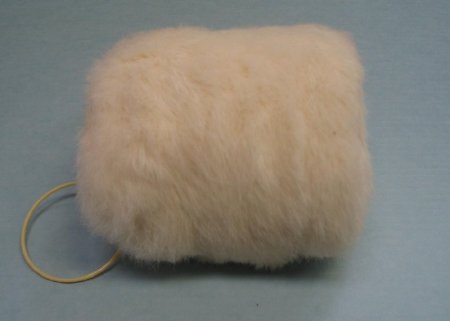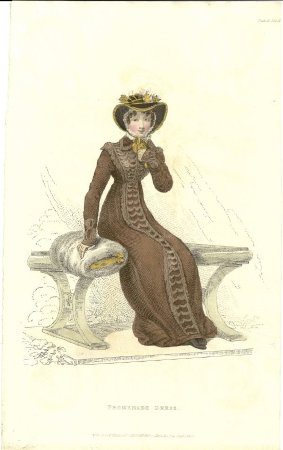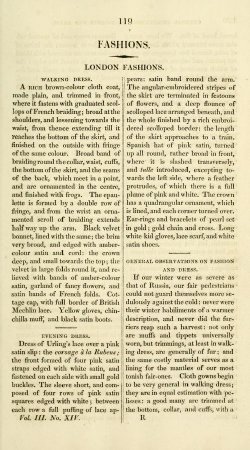Object ID:
2013.4.70
Label/Maker:
Ackermann, Rudolph
Date:
February 1, 1824
Learn More:
Object Story:
This Ackermann illustration features a winter ensemble including a long decorative pelisse style brown coat, gloves, ruffled bonnet, and a striking, oversized chinchilla muff. During the Regency period, fur was incorporated into a lady's wardrobe through key accessories. Fur tippets in the form of stoles or scarves and matching muffs were worn for both status and warmth. The muff was of particular significance pertaining to a stylish wardrobe for its elegance and functional design. Its cylindrical shape made from fabric or fur usually opened at both ends as a way of keeping arms and hands warm.27 The concept of this accessory actually dates to the 16th century as a unisex supplement which will shift in use for females. The size of muffs have varied overtime including grand scale, moderate and "muffetees which were worn to protect wrist ruffles when playing cards. Fur tippets and muffs were highly coveted as documented at Old Bailey, the court of criminal law for England and Wales, where quite a few cases of theft of these items are documented. If found guilty, the sentence ranged from prison/hard labour or transportation to the colonies for a period of seven years." 28
Symbolic Comparison:
The connections between the Regency Ackermann fashion plate and child's muff from the 1940s highlight moments in fashion history when fur accessories symbolized stylistic taste in response to environmental factors. "During the Regency period, fashion transformations were more notable and rapid than in any previous time in history. With the steady rise of industrialization came the impact of capitalism on society, and clothing served as a marker of the upward mobility that was newly available to many members of society."29 A chinchilla fur muff would certainly suit this trend noted for its dense silk-like material that was costly to produce. During the 1940s, the impact of WWII promoted governmental restrictions on fashion throughout Europe and the United States. As a result, accessories became a vehicle for style expression as individual's craved evidence of luxury in their wardrobes. A child's fur muff from this period, symbolizes a touch of glamour, beauty, and innocence.
References:
27 Britannica, T. Editors of Encyclopaedia, "Muff," Encyclopedia Britannica, September 22, 2010. https://www.britannica.com/topic/muff.
28 Sarah Murden, "Georgian Era Muffs, Tippets and Furs," All Things Georgian, February 23, 2016. https://georgianera.wordpress.com/2016/02/23/georgian-era-muffs-tippets-and-furs/.
29 Daniel James Cole, "Hierarchy and Seduction in Regency Fashion," Jane Austen Society of North America 33, no. 1 (2012), accessed November 25, 2020. http://www.jasna.org/persuasions/on-line/vol33no1/cole.html.
28 Sarah Murden, "Georgian Era Muffs, Tippets and Furs," All Things Georgian, February 23, 2016. https://georgianera.wordpress.com/2016/02/23/georgian-era-muffs-tippets-and-furs/.
29 Daniel James Cole, "Hierarchy and Seduction in Regency Fashion," Jane Austen Society of North America 33, no. 1 (2012), accessed November 25, 2020. http://www.jasna.org/persuasions/on-line/vol33no1/cole.html.



